Abstract
1. The actions of (+)-S-12967 and (-)-S-12968 two isomers of a new 1,4-dihydropyridine (DHP) derivative, were studied on 125 mM K(+)-, Ca(2+)- and noradrenaline-induced contractions in rat isolated mesenteric resistance arteries and compared to those of nifedipine. 2. The action of (+)-S-12967 and (-)-S-12968 was slow in onset in contrast to nifedipine. Both isomers had a dual contractile and relaxant action in arteries contracted with 125 mM K+; however, the (-)-isomer was about 300 times more potent than the (+)-isomer. The response to 125 mM K+, being depressed by 70%, recovered within 20 to 30 min for all DHP derivatives. All vessels were treated with 1 x 10(-6) M phenoxybenzamine thus excluding the possibility that the contraction is mediated by activation of amine-receptors. 3. Both (+)-S-12967 and (-)-S-12968 at low concentrations potentiated responses induced by Ca2+ in arteries activated by 125 mM K+ and inhibited the responses at higher concentrations. (+)-S-12967 and (-)-S-12968 had no contractile action in arteries kept in normal buffer. Nifedipine had only an inhibitory action on vessel responses to 125 mM K+ and Ca2+. 4. Both isomers and nifedipine depressed the maximal vessel response to noradrenaline by about 20% and 44%, respectively. 5. The results confirm that DHP calcium antagonists selectively inhibit vascular smooth muscle responses induced by high potassium and that the potency of 1,4-DHP isomers may vary considerably.(ABSTRACT TRUNCATED AT 250 WORDS)
Full text
PDF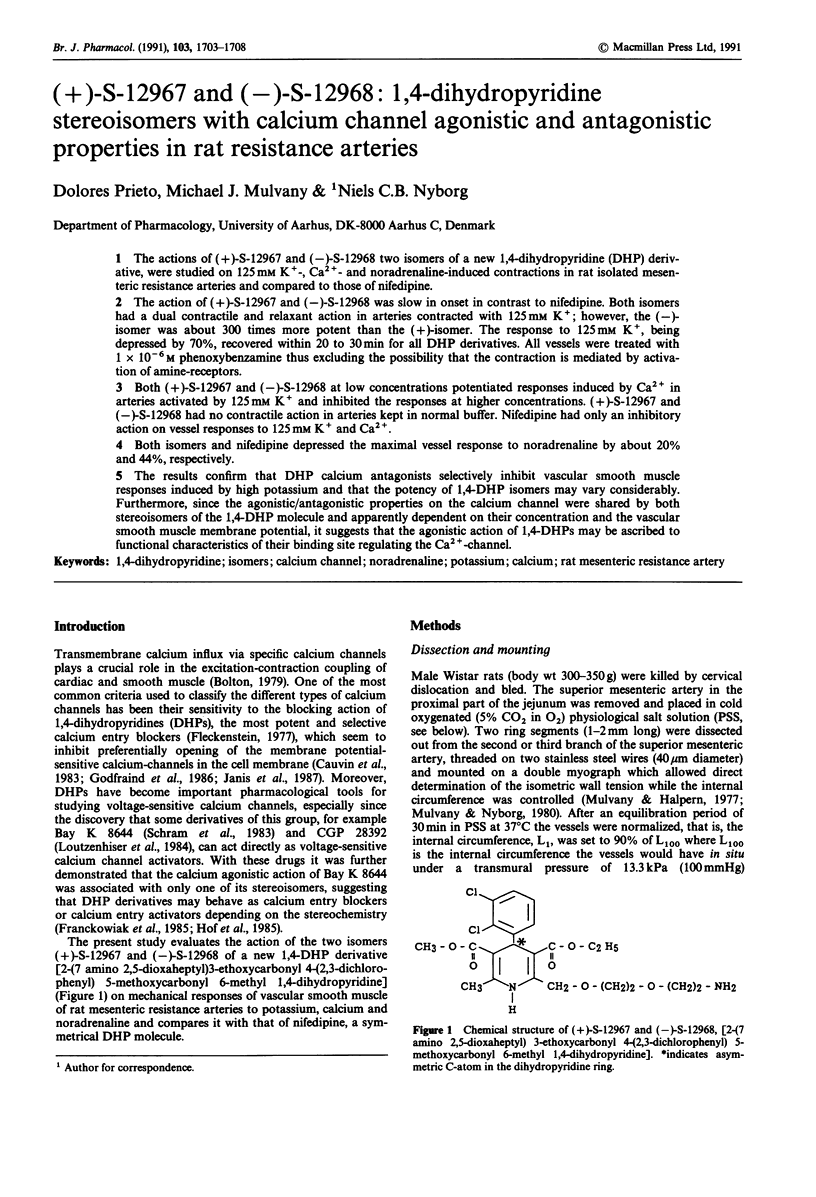
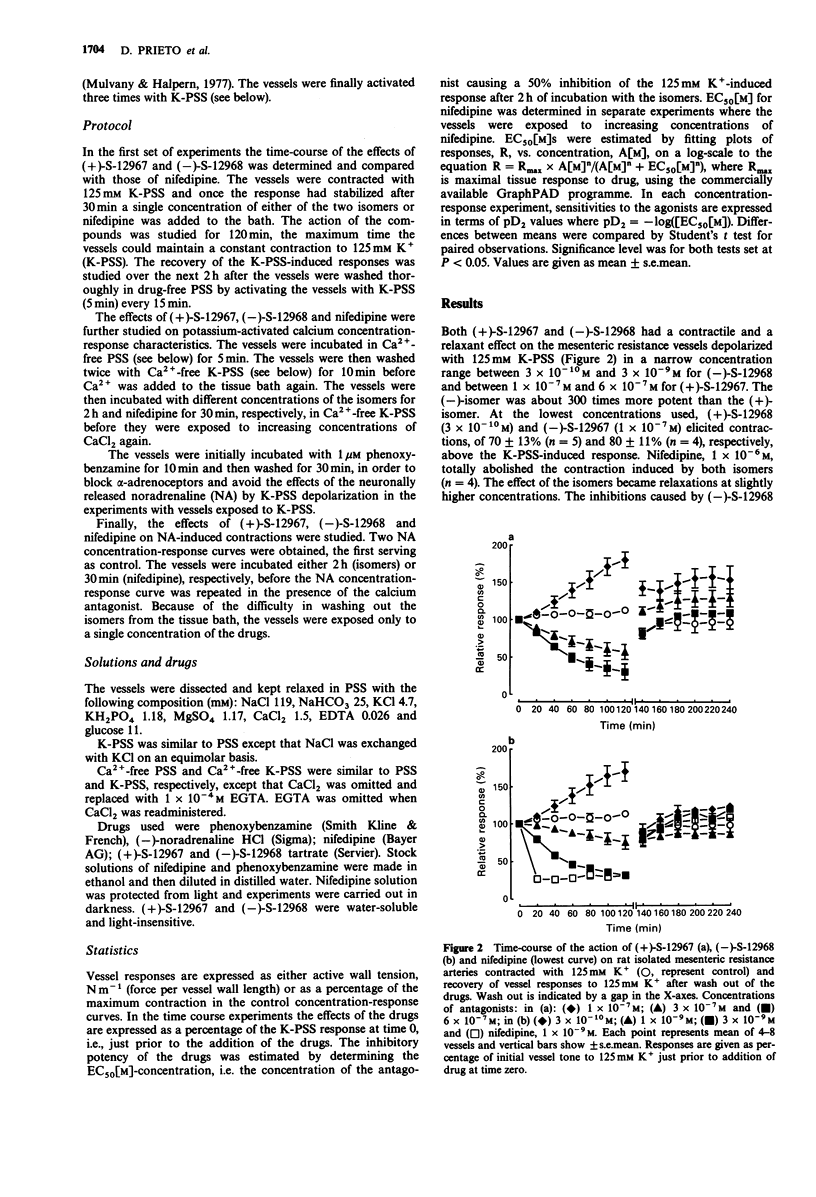
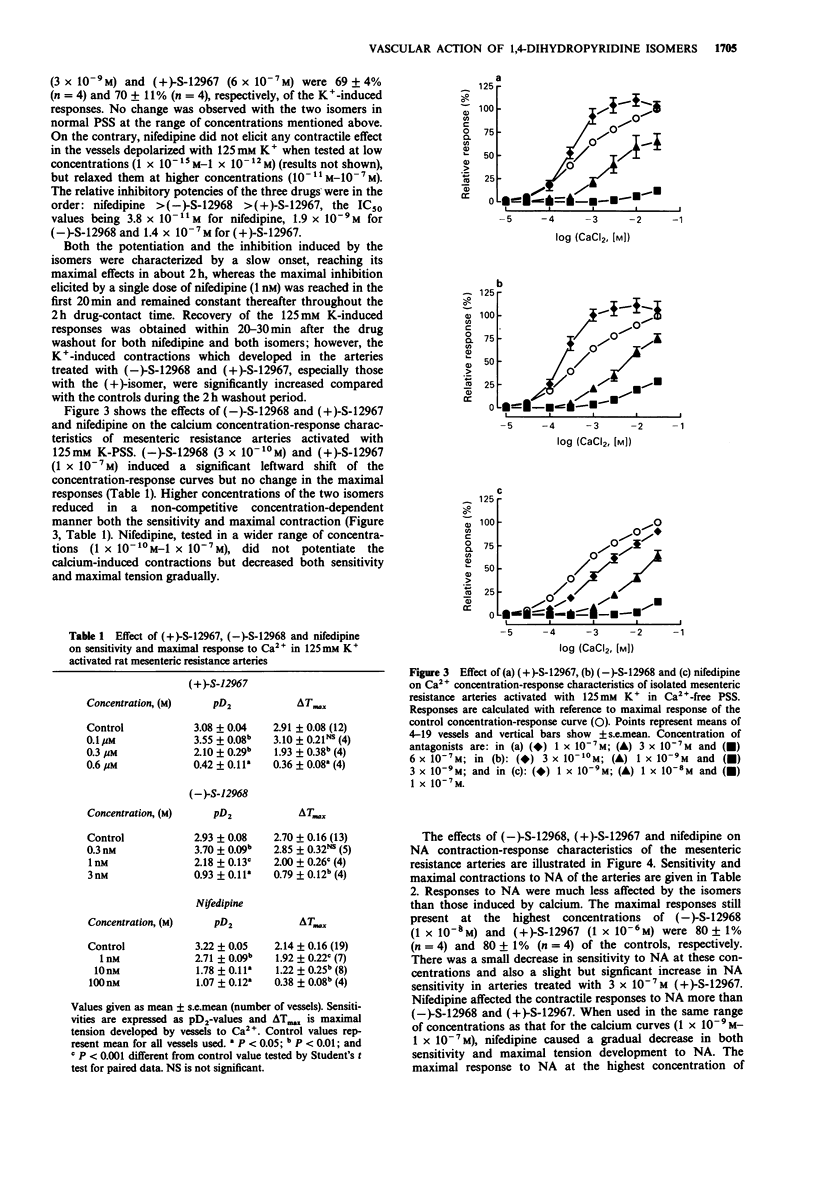
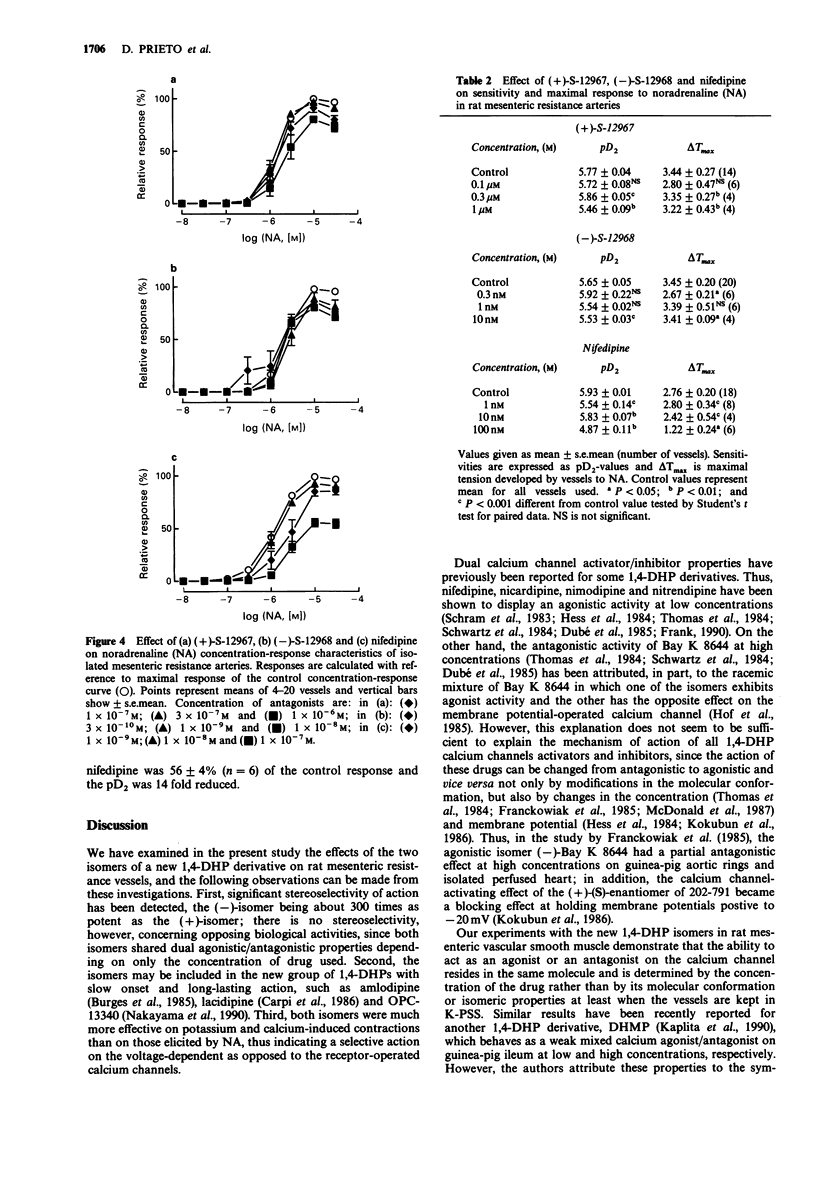
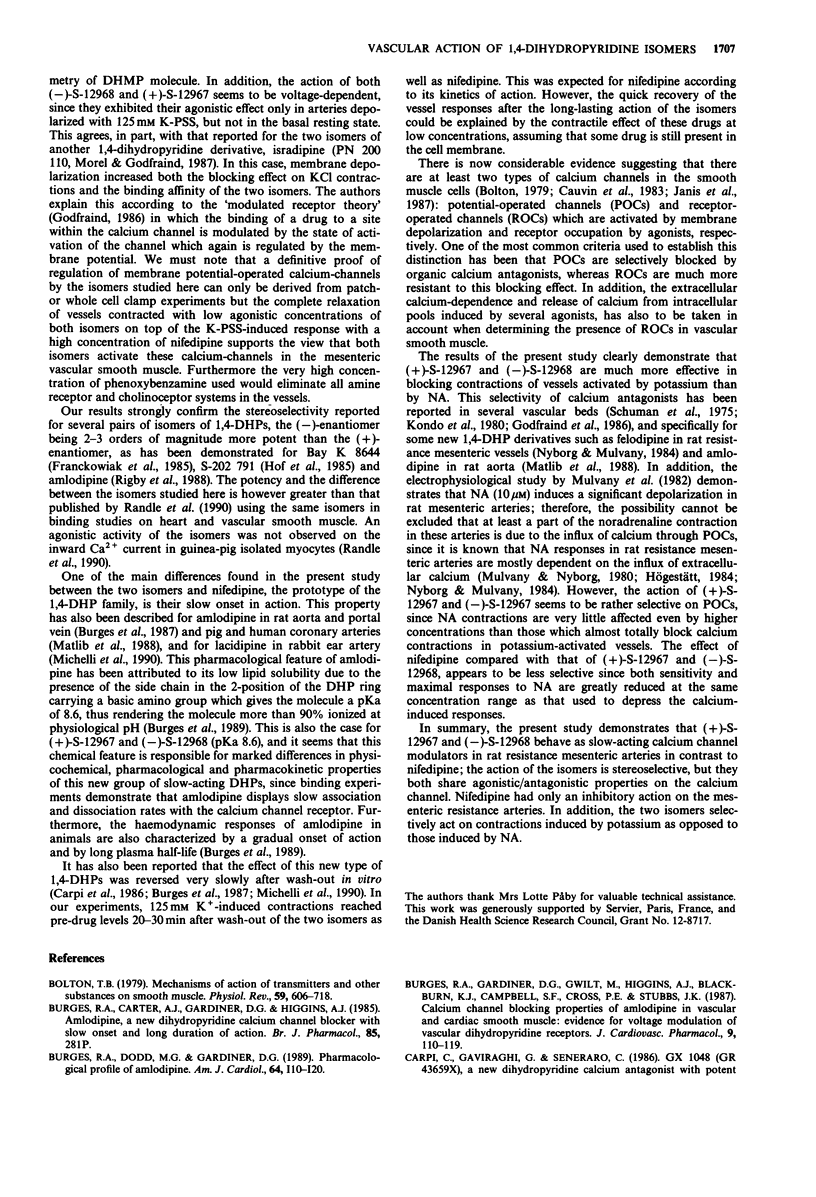
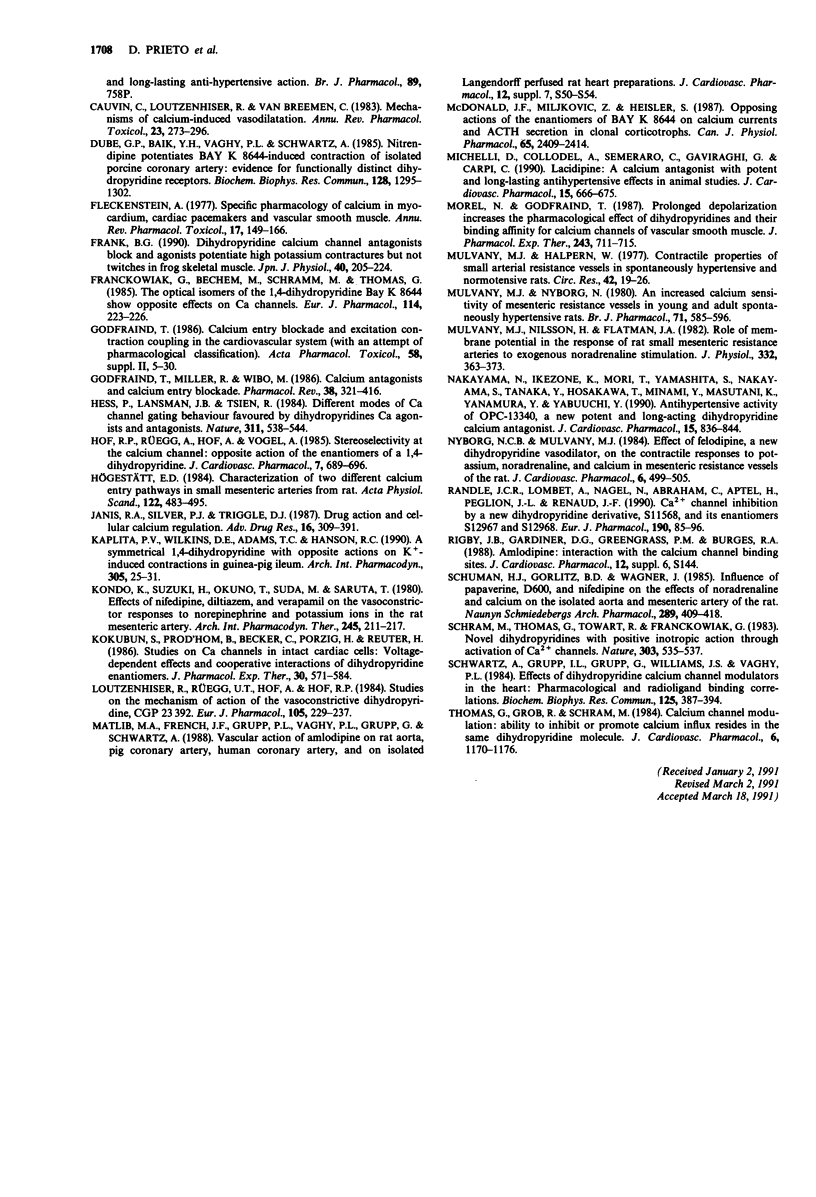
Selected References
These references are in PubMed. This may not be the complete list of references from this article.
- Bolton T. B. Mechanisms of action of transmitters and other substances on smooth muscle. Physiol Rev. 1979 Jul;59(3):606–718. doi: 10.1152/physrev.1979.59.3.606. [DOI] [PubMed] [Google Scholar]
- Burges R. A., Gardiner D. G., Gwilt M., Higgins A. J., Blackburn K. J., Campbell S. F., Cross P. E., Stubbs J. K. Calcium channel blocking properties of amlodipine in vascular smooth muscle and cardiac muscle in vitro: evidence for voltage modulation of vascular dihydropyridine receptors. J Cardiovasc Pharmacol. 1987 Jan;9(1):110–119. [PubMed] [Google Scholar]
- Dube G. P., Baik Y. H., Vaghy P. L., Schwartz A. Nitrendipine potentiates Bay k 8644-induced contraction of isolated porcine coronary artery: evidence for functionally distinct dihydropyridine receptor subtypes. Biochem Biophys Res Commun. 1985 May 16;128(3):1295–1302. doi: 10.1016/0006-291x(85)91081-2. [DOI] [PubMed] [Google Scholar]
- Fleckenstein A. Specific pharmacology of calcium in myocardium, cardiac pacemakers, and vascular smooth muscle. Annu Rev Pharmacol Toxicol. 1977;17:149–166. doi: 10.1146/annurev.pa.17.040177.001053. [DOI] [PubMed] [Google Scholar]
- Franckowiak G., Bechem M., Schramm M., Thomas G. The optical isomers of the 1,4-dihydropyridine BAY K 8644 show opposite effects on Ca channels. Eur J Pharmacol. 1985 Aug 15;114(2):223–226. doi: 10.1016/0014-2999(85)90631-4. [DOI] [PubMed] [Google Scholar]
- Frank G. B. Dihydropyridine calcium channel antagonists block and agonists potentiate high potassium contractures but not twitches in frog skeletal muscle. Jpn J Physiol. 1990;40(2):205–224. doi: 10.2170/jjphysiol.40.205. [DOI] [PubMed] [Google Scholar]
- Godfraind T. Calcium entry blockade and excitation contraction coupling in the cardiovascular system (with an attempt of pharmacological classification). Acta Pharmacol Toxicol (Copenh) 1986;58 (Suppl 2):5–30. doi: 10.1111/j.1600-0773.1986.tb02518.x. [DOI] [PubMed] [Google Scholar]
- Godfraind T., Miller R., Wibo M. Calcium antagonism and calcium entry blockade. Pharmacol Rev. 1986 Dec;38(4):321–416. [PubMed] [Google Scholar]
- Hess P., Lansman J. B., Tsien R. W. Different modes of Ca channel gating behaviour favoured by dihydropyridine Ca agonists and antagonists. Nature. 1984 Oct 11;311(5986):538–544. doi: 10.1038/311538a0. [DOI] [PubMed] [Google Scholar]
- Hof R. P., Rüegg U. T., Hof A., Vogel A. Stereoselectivity at the calcium channel: opposite action of the enantiomers of a 1,4-dihydropyridine. J Cardiovasc Pharmacol. 1985 Jul-Aug;7(4):689–693. doi: 10.1097/00005344-198507000-00012. [DOI] [PubMed] [Google Scholar]
- Högestätt E. D. Characterization of two different calcium entry pathways in small mesenteric arteries from rat. Acta Physiol Scand. 1984 Dec;122(4):483–495. doi: 10.1111/j.1748-1716.1984.tb07537.x. [DOI] [PubMed] [Google Scholar]
- Kaplita P. V., Wilkins D. E., Adams T. C., Hanson R. C. A symmetrical 1,4-dihydropyridine with opposite actions on K(+)-induced contractions in guinea-pig ileum. Arch Int Pharmacodyn Ther. 1990 May-Jun;305:25–31. [PubMed] [Google Scholar]
- Kokubun S., Prod'hom B., Becker C., Porzig H., Reuter H. Studies on Ca channels in intact cardiac cells: voltage-dependent effects and cooperative interactions of dihydropyridine enantiomers. Mol Pharmacol. 1986 Dec;30(6):571–584. [PubMed] [Google Scholar]
- Kondo K., Suzuki H., Okuno T., Suda M., Saruta T. Effects of nifedipine, diltiazem and verapamil on the vasoconstrictor responses to norepinephrine and potassium ions in the rat mesenteric artery. Arch Int Pharmacodyn Ther. 1980 Jun;245(2):211–217. [PubMed] [Google Scholar]
- Loutzenhiser R., Rüegg U. T., Hof A., Hof R. P. Studies on the mechanism of action of the vasoconstrictive dihydropyridine, CGP 28392. Eur J Pharmacol. 1984 Oct 15;105(3-4):229–237. doi: 10.1016/0014-2999(84)90614-9. [DOI] [PubMed] [Google Scholar]
- MacDonald J. F., Miljkovic Z., Heisler S. Opposing actions of the enantiomers of BAY-K-8644 on calcium currents and ACTH secretion in clonal pituitary corticotrophs. Can J Physiol Pharmacol. 1987 Dec;65(12):2409–2414. doi: 10.1139/y87-382. [DOI] [PubMed] [Google Scholar]
- Matlib M. A., French J. F., Grupp I. L., Van Gorp C., Grupp G., Schwartz A. Vasodilatory action of amlodipine on rat aorta, pig coronary artery, human coronary artery, and on isolated Langendorff rat heart preparations. J Cardiovasc Pharmacol. 1988;12 (Suppl 7):S50–S54. doi: 10.1097/00005344-198812007-00011. [DOI] [PubMed] [Google Scholar]
- Micheli D., Collodel A., Semeraro C., Gaviraghi G., Carpi C. Lacidipine: a calcium antagonist with potent and long-lasting antihypertensive effects in animal studies. J Cardiovasc Pharmacol. 1990 Apr;15(4):666–675. [PubMed] [Google Scholar]
- Morel N., Godfraind T. Prolonged depolarization increases the pharmacological effect of dihydropyridines and their binding affinity for calcium channels of vascular smooth muscle. J Pharmacol Exp Ther. 1987 Nov;243(2):711–715. [PubMed] [Google Scholar]
- Mulvany M. J., Halpern W. Contractile properties of small arterial resistance vessels in spontaneously hypertensive and normotensive rats. Circ Res. 1977 Jul;41(1):19–26. doi: 10.1161/01.res.41.1.19. [DOI] [PubMed] [Google Scholar]
- Mulvany M. J., Nilsson H., Flatman J. A. Role of membrane potential in the response of rat small mesenteric arteries to exogenous noradrenaline stimulation. J Physiol. 1982 Nov;332:363–373. doi: 10.1113/jphysiol.1982.sp014418. [DOI] [PMC free article] [PubMed] [Google Scholar]
- Mulvany M. J., Nyborg N. An increased calcium sensitivity of mesenteric resistance vessels in young and adult spontaneously hypertensive rats. Br J Pharmacol. 1980;71(2):585–596. doi: 10.1111/j.1476-5381.1980.tb10977.x. [DOI] [PMC free article] [PubMed] [Google Scholar]
- Nakayama N., Ikezono K., Mori T., Yamashita S., Nakayama S., Tanaka Y., Hosokawa T., Minami Y., Masutani K., Yamamura Y. Antihypertensive activity of OPC-13340, a new potent and long-acting dihydropyridine calcium antagonist, in rats. J Cardiovasc Pharmacol. 1990 May;15(5):836–844. doi: 10.1097/00005344-199005000-00021. [DOI] [PubMed] [Google Scholar]
- Nyborg N. C., Mulvany M. J. Effect of felodipine, a new dihydropyridine vasodilator, on contractile responses to potassium, noradrenaline, and calcium in mesenteric resistance vessels of the rat. J Cardiovasc Pharmacol. 1984 May-Jun;6(3):499–505. doi: 10.1097/00005344-198405000-00019. [DOI] [PubMed] [Google Scholar]
- Randle J. C., Lombet A., Nagel N., Abraham C., Aptel H., Peglion J. L., Renaud J. F. Ca2+ channel inhibition by a new dihydropyridine derivative, S11568, and its enantiomers S12967 and S12968. Eur J Pharmacol. 1990 Nov 6;190(1-2):85–96. doi: 10.1016/0014-2999(90)94115-e. [DOI] [PubMed] [Google Scholar]
- Schramm M., Thomas G., Towart R., Franckowiak G. Novel dihydropyridines with positive inotropic action through activation of Ca2+ channels. Nature. 1983 Jun 9;303(5917):535–537. doi: 10.1038/303535a0. [DOI] [PubMed] [Google Scholar]
- Schwartz A., Grupp I. L., Grupp G., Williams J. S., Vaghy P. L. Effects of dihydropyridine calcium channel modulators in the heart: pharmacological and radioligand binding correlations. Biochem Biophys Res Commun. 1984 Nov 30;125(1):387–394. doi: 10.1016/s0006-291x(84)80380-0. [DOI] [PubMed] [Google Scholar]
- Schümann H. J., Görlitz B. D., Wagner J. Influence of papaverine, D600, and nifedipine on the effects of noradrenaline and calcium on the isolated aorta and mesenteric artery of the rabbit. Naunyn Schmiedebergs Arch Pharmacol. 1975;289(4):409–418. doi: 10.1007/BF00508414. [DOI] [PubMed] [Google Scholar]
- Thomas G., Gross R., Schramm M. Calcium channel modulation: ability to inhibit or promote calcium influx resides in the same dihydropyridine molecule. J Cardiovasc Pharmacol. 1984 Nov-Dec;6(6):1170–1176. [PubMed] [Google Scholar]


